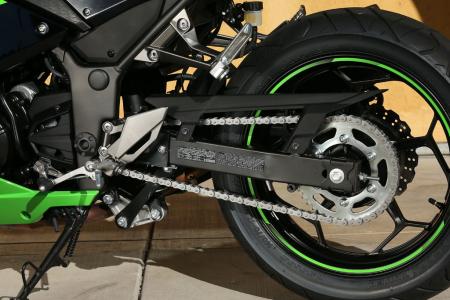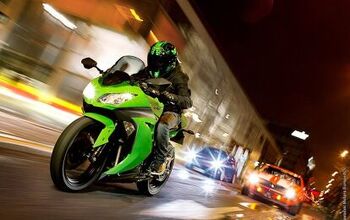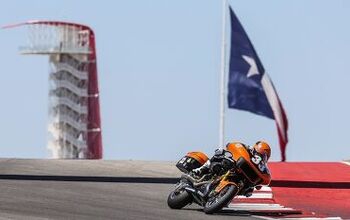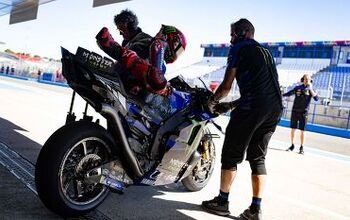2013 Kawasaki Ninja 300 Review - Motorcycle.com
Bad news for those who own a motorcycle in the quarter-liter category: the 2013 Kawasaki Ninja 300 has officially made your bike obsolete. After feeling the pressure as bikes like the CBR250 started to encroach on the beginner bike market share Kawasaki has virtually dominated for two decades, Team Green saw it fit to elevate the stakes even more by dramatically revamping the venerable Ninja 250 into what is now the 300.
Last week, we covered the details surrounding the Ninja 300 during its U.S. unveil in Times Square in New York City. In short, a longer stroke (48.0 mm vs. 41.2 mm) is responsible for the displacement spike. Connecting rods and pistons were lightened, shortened and strengthened to cope with the extra power while maintaining the same deck height and 13,000-rpm redline as the 250.
Besides the bigger engine, digital fuel injection finally makes its way onto the baby Ninja. Equipped on Euro-spec Ninja 250s for a few years, 2013 marks the first time it’s been made available in America. Benefits are substantial: easy startup (especially useful in cold weather), smoother idle, more precise throttle response, cleaner emissions, and vastly improved fuel economy. Throttle bodies measure 32mm, and the intake tract utilizes dual throttle valves for more precise fueling throughout the rev range.
Kawasaki tests showed the existing clutch in the 250 couldn’t handle the increased torque from the 296cc engine. So it turned to Japanese firm F.C.C., who delivered a new, stronger unit featuring “assist” and slipper functions. You’re likely familiar with slipper clutches by now, as it’s extremely effective in limiting rear-wheel lockup during aggressive or sloppy downshifts. The assist function results in a light clutch pull many riders, new or experienced, will appreciate.
Optional ABS is the next major improvement and feature of the new 300. Using a Nissin ABS unit weighing only 631 grams, it’s 60% lighter than any existing Nissin unit available, and Kawasaki claims it’s the lightest and smallest ABS unit available on any current production motorcycle.
Who Cares?
Why is Kawasaki focusing so much on the little Ninjette? Team Green reps revealed sales figures showing “lightweight sportbikes” far surpassing sales of both middleweight and liter-class motorcycles.
Though Kawasaki doesn’t give specific sales numbers, Product Manager Croft Long also revealed the company has been able to retain approximately 40% of Ninjette owners who choose to move on to bigger, faster machinery instead of losing them to competitor brands. That’s big.
So while the experienced rider may scoff at such updates on what may be considered a “beginner bike,” from a sales perspective, Kawasaki has a lot riding on the new 300.
No Replacement For Displacement
Kawasaki invited journalists to Healdsburg, California, to get a taste of the Ninja 300 in and around the Northern California coast. Our ride route traversed Skaggs Springs Road, a popular destination in these parts, which provided everything from picturesque twisty roads, to bumpy two-lane byways. Perfect for putting the Ninja through its paces. A 2012 Ninja 250 was also on hand to draw back-to-back comparisons.
Immediately noticeable is the convenience of fuel injection. No longer is there a need to fiddle with the choke and wait for the bike to warm up like on the lean-jetted 250. On the 300, simply press the starter, put it in gear and ride off. Throttle response from the 300 is more precise than its predecessor, especially while still cold.
Then of course, there’s the power. With more displacement comes more torque and horsepower throughout the rev range, and the Ninja 300 leaves the 250 in its wake. More importantly, many 250 riders often feel they’ve outgrown the category quickly and make the jump to 600s or beyond, arguably before they should. With the 300, this power bump should be enough for the new rider to consider keeping the bike longer while learning valuable riding skills.
It may be because we rode the first batch of 300s to make it to these shores (the stamp on the headstock stated a build date of August, 2012, only a month before this event), but clutchless upshifts through the first few gears felt notchy. This feeling lessened with more miles, however.
Clutch lever pull is light as advertised, and the slipper function mostly works as claimed, though downshifting from fifth to first and dumping the clutch does cause minor lockage. But that’s an extreme example.
Kawasaki claims a 150% stronger frame via high-tensile steel main tubes and added gusseting. The result is dramatically improved longitudinal rigidity, especially noticeable when riding old and new at a spirited pace. Get to the twisty stuff, and the increased chassis stiffness is immediately apparent. Where the 300 feels composed and ready to attack the next corner, at the same pace the 250 feels manic and on edge.
The added composure of the new bike can also be attributed to revised damping rates at both ends. Front compression and rebound on the non-adjustable fork were softened to complement the stiffer frame, while more fork oil is used to resist bottoming.
Firmer compression and rebound damping is dialed into the rear shock, which is only adjustable for preload. A shorter shock spring maintains the same spring rate as before. The changes work, as the 300 is much more resistant to bottoming than the 250, and it feels more composed mid-turn as well.
Weighing in at only 380 pounds ready-to-ride (384 with ABS), changing direction is done quickly and easily. The bars provide decent leverage, and the IRC RX-01R tires perform quite admirably, even at a spirited pace. Front tire size remains the same as before at 110/70-17, but as the rear wheel grew in width, rear tire size also increased to 140/70-17. Ten millimeters wider than last year.
Reeling in the Ninja 300 is a single 290mm wave-type disc in front and 220mm wave disc in the rear, both mated to twin-piston calipers. Standard models are equipped with resin brake pads front and rear, while ABS model get sintered pads in front. Kawasaki reps say this is to achieve the desired lever feel engineers felt was suitable for new riders.
That said, ABS works well, with little pulsing at the lever. For most riders, especially new riders who likely won’t push to the levels we did during our ride, the added safety and peace of mind ABS offers is worth the tradeoff in lever feel.
In many ways, the Ninja 300 feels awfully similar to its predecessor. Seat height has increased slightly to 30.9 inches instead of 30.5 on the 250, though the difference is hardly felt as the new seat is slimmer at the front, allowing a very easy reach to the ground. The rider layout of the two bikes feels virtually identical.
The rider triangle places the rider in the slightest of forward cants, with very little pressure on the wrists. There’s little room to scoot back in the saddle, and considering my 5-foot, 8-inch frame saw knees touching elbows often, taller riders might feel a bit cramped.
Styling has obviously changed as well, to reflect more of the DNA from its ZX-6R and ZX-10R siblings. Gone is the single headlight, replaced by the split design. Fairing vents have moved around, the fuel tank is reshaped slightly, and its tail is slightly slimmer and receives integrated grab handles underneath for pillions.
The Return of the Beginner Bike King
With the Ninja 300, Kawasaki has all but assured its place back on top of the beginner bike field. It clearly outclasses its predecessor, and though Honda’s CBR250 is a worthy competitor with its fuel injected engine, light weight and nimble handling, its lack of power even compared to the Ninja 250 is a detriment. The Ninja 300 isn’t any more intimidating to ride for the new rider and provides levels of performance they can learn to take advantage of as their skills improve.
As impressive as it is, the biggest setback for prospective Ninja 300 buyers is price. At $4799 for standard models and $5499 for ABS versions, the cost of entry is rather steep relative to the CBR250’s $3999 base price ($500 extra with ABS). However, it’s important to factor in the Ninja’s performance levels that are far above its immediate rivals.
It’s extremely fuel efficient, too. Kawasaki held a mpg contest for the assembled journalists to see who could squeeze the most distance from the least fuel. Some journos deliberately tried to get the worst mileage around the pre-planned course, while others, including yours truly, stayed true to the original intent.
At the end of the 32-mile course, the winner recorded an astounding 105 mpg! Perhaps more impressive, the worst of the floggers still recorded 50 mpg! I logged the second best figure at 103 mpg. It took incredibly slow speeds and drastic measures to reach the triple digit mark, however. Still, under normal conditions, expect numbers in the high 60s or low 70s. With 4.5 gallons of fuel onboard, you’ll go pretty far before looking for a gas station.
With all of these factors in mind, if I were suggesting a bike to a new rider, I couldn’t think of a reason not to steer them towards a Ninja 300. Expect bikes to hit dealers near the end of October.
Check out KawasakiNinja300.com for all the latest chatter on all things Ninja 300.
Related Reading
KawasakiNinja300.com
2013 Kawasaki Ninja 300 Preview
2013 Kawasaki Ninja 300 Confirmed for Canada – US Availability Likely to Follow
2013 Kawasaki Ninja 300 Announced – for Europe
EPA Documents Reveal 2013 Kawasaki Ninja 300, 400R, Confirms 636cc Ninja ZX-6R
Motorcycle Beginner: 2011 Honda CBR250R Newbie Review
2011 250cc Beginner Bike Shootout
2011 Honda CBR250R Review2010 Kawasaki Ninja 250R Review
More by Troy Siahaan








































Comments
Join the conversation